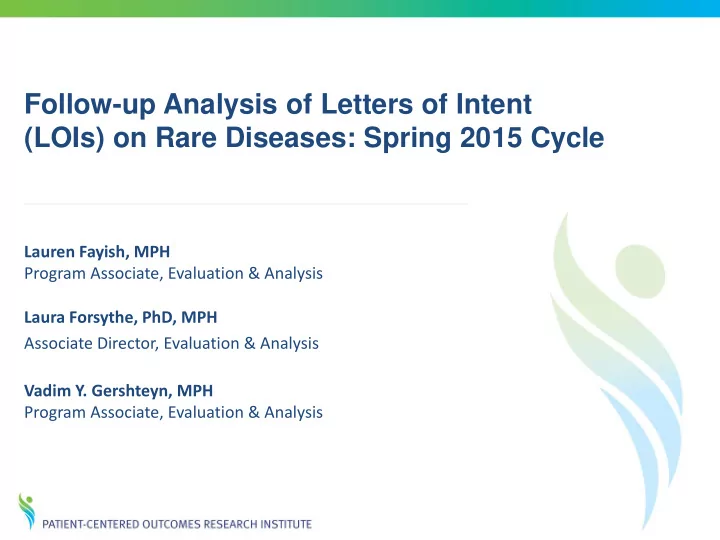

Follow-up Analysis of Letters of Intent (LOIs) on Rare Diseases: Spring 2015 Cycle Lauren Fayish, MPH Program Associate, Evaluation & Analysis Laura Forsythe, PhD, MPH Associate Director, Evaluation & Analysis Vadim Y. Gershteyn, MPH Program Associate, Evaluation & Analysis
Funded Projects on Rare Disease • Through April 2015, PCORI has 49 awards on Rare Diseases • 18 through Broad Funding Announcements (6%) • 3 Pilot Projects (6%) • 20 Networks (100% of Clinical Data Research Networks; 50% of Patient-Powered Research Networks) • 5 Pipeline to Proposal awards (6%) • 3 Engagement awards (8%)
PI Institutional Affiliation † for Rare Disease Applicants in Broad Funding Announcements Cycle III - Spring 2014 All Rare Disease Applicants (n=51) Funded Rare Disease Applicants (n=10) Research Institute, 3 Advocacy, 5 Research Government, Institute, 2 1 University, University, 5 28 Hospital Hospital System, 14 System, 3 †PI self-reported
Evaluation of Applications on Rare Diseases • RDAP presented PCORI with questions about Merit Review for applications on rare diseases • How many applications on rare diseases are reviewed, discussed, and funded compared to other conditions? • Compared to other applications, how likely are applications on rare diseases • to be discussed (i.e., part of the review slate at the in-person panels)? Why? • to be funded? Why?
Summary of Findings (presented Jan 2015) • Applications on rare diseases are not disadvantaged in PCORI Merit Review – More likely to be discussed at in-person panels – More likely to be funded – Score similarly or better on each criterion • However, PCORI received a limited number of applications on rare diseases
Action Steps • Set aside funding for rare disease research in the Spring 2015 PFA ($12 M) • Applications on rare diseases will be reviewed in separate panel(s) to ensure relevant experts are included
Spring 2015 LOIs: Rare vs. Other Conditions 57% of LOIs on rare diseases invited vs. 41% of other LOIs - LOIs on rare diseases account for 15% of all invited LOIs - Invited Not Invited 250 193 200 Number of LOIs 150 134 100 50 24 18 0 Rare Conditions Other Conditions Spring 2015 Cycle
Purpose of LOI Analysis • PCORI conducted an analysis of Letters of Intent (LOIs) on rare diseases to understand the characteristics of LOIs that were invited for a full application vs. those that were not invited Spring 2015 Cycle
Principal Investigator Stakeholder Community † LOIs on rare diseases Invited (n=24) Not Invited (n=18) Advocacy Training Industry, 1 organization, Institution, 1 Clinic/Hospita 1 Caregiver, 1 l/Health system, 3 Clinic/Hospit al/Health system, 1 Research, 10 Research, 8 Clinician, 10 Clinician, 6 †PI self-reported Spring 2015 Cycle
Patient-Stakeholder Partners LOIs on rare diseases Invited (n=24) Not Invited (n=18) Not yet Not yet Individual Individual specified specified Patients Patients 13% 17% 17% 17% Non- Non- Profit/Advocacy Profit/Advocac Organization y Organization 71% 67% Spring 2015 Cycle
Pediatric Population Addressed LOIs on rare diseases 100% 90% 80% % LOIs Addressing Children 70% 60% 54% 50% 40% 28% 30% 20% 10% 0% Invited Not Invited Spring 2015 Cycle
Care Continuum LOIs on rare diseases Invited (n=24) Not Invited (n=18) Prevention † Diagnosis 8% 4% Diagnosis 22% Treatment Treatment 78% 88% † includes one primary prevention LOI and one secondary prevention LOI Spring 2015 Cycle
Study Design LOIs on rare diseases Invited (n=24) Not Invited (n=18) Secondary Secondary Data Data Analysis Analysis 17% 17% Randomized Randomized Control Trial Observation Control Trial 42% al 50% Observation 33% al 42% Spring 2015 Cycle
Comparators † LOIs on rare diseases Invited (n=24) Not Invited (n=18) Usual Care as the Sole Two or More Usual Care Comparator Active as the Sole 25% Comparator Comparator s 39% 39% Two or More Active Comparators 75% Pre/Post Comparison 22% †”Usual care” is PI-defined standard of care practice Spring 2015 Cycle
Thank You
Recommend
More recommend